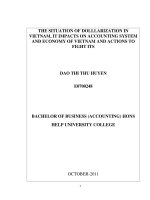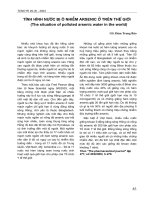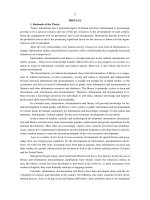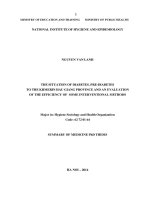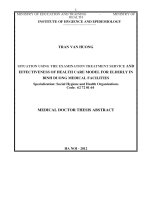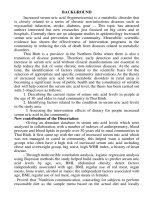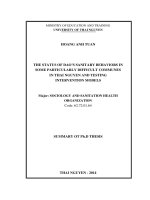the situation of sanitation behavior of dao people in some particularly difficult communes of thai nguyen province and testing intervention models
Bạn đang xem bản rút gọn của tài liệu. Xem và tải ngay bản đầy đủ của tài liệu tại đây (281.41 KB, 26 trang )
MINISTRY OF EDUCATION AND TRAINING
UNIVERSITY OF THAI NGUYEN
HOANG ANH TUAN
THE STATUS OF DAO’S SANITARY BEHAVIORS IN
SOME PARTICULARLY DIFFICULT COMMUNES
IN THAI NGUYEN AND TESTING
INTERVENTION MODELS
Major: SOCIOLOGY AND SANITATION HEALTH
ORGANIZATION
Code: 62.72.01.64
SUMMARY OT Ph.D THESIS
THAI NGUYEN - 2014
The work has been completed in
University of Medicine & Pharmacy – Thai Nguyen
University
Science Superviors:
1. Assoc.Prof.,Dr Dam Khai Hoan
2. Assoc.Prof.,Dr Nguyen Van Hien
Opponent 1:
Opponent 2:
Opponent 3:
The thesis will be protected in Thesis Committee in National
Level held in University of Medicine and Pharmacy - Thai
Nguyen University at in , 20
The information from this thesis can be found:
Library of Thai Nguyen University of Medicine and Pharmacy
Learning Resource Center – Thai Nguyen University
National Library
LIST OF PUBLISHED WORKS RELATED TO THESIS
1. Hoang Anh Tuan, Dam Khai Hoan, Nguyen Van Hien
(2014), “The reality of knowledge, attitude and practice of
environmental sanitation in some of the Dao extremely difficult
communes in Thai Nguyen Province", Journal of Science and
Technology, Journal of Agriculture, Biology-Medicine, Thai
Nguyen University, vol 123 (09)/2014, p. 3-10.
2. Hoang Anh Tuan, Dam Khai Hoan, Nguyen Van Hien
(2014), "A number of factors related to environmental hygiene
behavior in 4 of the Dao extremely difficult communes in Thai
Nguyen," Journal of Practical Medicine, (7; 925), p. 149-152
3. Hoang Anh Tuan, Dam Khai Hoan, Nguyen Van Hien
(2014), "Effective interventions on environmental sanitation of the
Dao in communes with special difficulties of Vo Nhai, Thai
Nguyen," Journal of Practical Medicine, (7; 924), p. 58-61
1
BACKGROUND
Northern mountainous Vietnam is the main living area of the
minority ethnic communities in Vietnam ethnic groups such as Tay,
Nung, Thai, Muong, Dao, H'mong These are the areas with difficult
transportation, low literacy levels by existing many outdated traditions,
many potential risks of environmental pollution caused by man himself.
The percentage of households with clean water, sanitary latrines is very
low, the main cause is being not good at environmental hygiene
behaviors. Dao people mainly live in the remote areas throughout
Vietnam-China border from Lai Chau to Ha Giang province. General
characteristics of Dao people are underdeveloped economic, cultural,
society, and poor environmental hygiene. The question is what the status
of the Dao sanitary behaviors in some particularly difficult communes of
Thai Nguyen province now is? What factors affect Dao’s sanitary
behaviors? And whether the communication models of health and
education can improve sanitary behaviors or not? To answer above
questions, we conducted a research on "The Status of Dao’s sanitary
behaviors in some particularly difficult communes in Thai Nguyen and
testing intervention models" with the objectives:
1. Assess the situation of the Dao’s sanitary behaviors in some
extremely difficult communes in Thai Nguyen 2011.
2. Describe some factors related to Dao’s sanitary behaviors in
some extremely difficult communes in Thai Nguyen province.
3. Assess the result of the testing the communication models in
changing sanitary behaviors for Dao people in Vu Chan commune, Vo
Nhai district, Thai Nguyen province.
2
THE NEW CONTRIBUTIONS OF THE THESIS
1. The result of the thesis has described the overall big picture of the
current status of the Dao’s sanitary behavior living in particularly
difficult communes in Thai Nguyen province.
2. This is the first intervention study in the Dao community which has
provided the evidence, factors related to environmental hygiene
behaviors of the Dao living in particularly difficult communes in Thai
Nguyen province.
3. The Model "Communication in changing sanitary behaviors for the
Dao in Vu Chan commune" has been mobilizing the resources of the
community, the prestigious Dao people participating in the programe to
improve the sanitary behavior for them. The research model is integrated
into The primary Health care Committee of the commune, functions and
duties assigned specificly and clearly with the pivotal role which is the
Fatherland Front. This is the basis for the model to develop sustainably
and feasibility.
STRUCTURE OF THE THESIS
The main thesis with 126 pages is composed by the following parts:
Introduction: 2 pages
Chapter 1 - Overview: 31 pages
Chapter 2 - Objects and methods of research: 18 pages
Chapter 3 - Findings: 39 pages
Chapter 4 - Discussion: 34 pages
Conclusion and Recommendation: 2 pages
The thesis has 126 references, including 82 Vietnamese
documents and 44 English ones. The thesis consists of 24 quantitative
result tables, 5 charts, 4 diagrams, 1 figures and 5 qualitative result
boxes. The appendix includes 7 appendixes, 25 pages.
3
Chapter 1. OVERVIEW
1.1. Current status of sanitary behaviors of the Dao in Vietnam
According to WHO "Human behavior is a complex set of actions,
but these actions are influenced by many inside and outside, subjective
and objective factors."
Behaviors are influenced by internal factors such as knowledge,
attitudes, beliefs, values, personal experience of practice, behavior and
external factors such as legislation, regulations, family, friends, the
reputed people The activities have repeated several times, gradually
become a lifestyle. Lifestyle is also influenced by anthropology, culture,
society, psychological factors Lifestyle is a set of behaviors, creating a
human life, including many specific issues such as practice personal
hygiene and the use of sanitary facilities, living habits of individuals,
families and communities, customs Every behavior is a specific
expression outside and affected by many elements that are knowledge,
attitude, practice (KAP) and the belief of people in a certain work or
situation.
1.1.1. Behavior in using clean water of Dao people
Results of the survey of Preventive Medicine and Environment
Department in 2010, on the environmental hygiene conditions of some
ethnic minorities in Vietnam showed that the Dao mainly used headwater
streams and wells, very few people use tap water, rain water and wells:
57.6% of households using water from headwater streams, 18.3% of
households using water from wells; few households using other water
sources (0.7% of households using well water); not any households use
tap water and rain water. However, 2.1% of households still use water
from rivers, lakes, and 21.4% are using other sources of water which is
not clean. Nearly half of Dao households in the survey (49.7%) admitted
drinking (unboiled) water.
1.1.2. Behavior in using Latrine of the Dao
Some studies of Hoan, D.K (2003), Hoc, N.D (2003) showed that
the proportion of the Dao households who have latrines accounted for
50.4% of the surveyed households, but the proportion of households with
suitable latrines were very low, only 5.8%. Of which there were only
5.1% of two separated compartment latrines, 0.3% of septic latrines,
0.3% of absorbed flush toilets. The Dao households who have no latrines
defecate to the gardens and forests (85.5%), use the others’ households
4
(4.5%) or to the barn (10%). Reasons for not building latrine of the Dao
is like the other minorities, mostly "no money" (76.9%); "no need"
(21.3%) and "do not like" (1.2%).
1.2. The affects of habits on the sanitation health of the Dao
According to the census of population and houses in 2009, the Dao
in Vietnam has a population of 751,067 people, accounting for 0.87% of
the whole national population, ranking 9th in ethnic groups, ranking 2nd
in countries where the Dao live, residing in 61 out of 63 provinces and
cities. The Dao (other names: Man, Dong, Trai, Diu Mien, Kim Mien,
Lu Gang, Lan Ten, Dai Ban, Tieu Ban, Coc Ngang, Coc Mun, Son
Dau etc) usually live in the valleys, low hills, surrounding foothills or
along streams, where has headwater. They live in clusters, small separate
hamlets and people gathered around the theocratic, with particular
characteristics on the traditions and the most evidence is on their clothes
such as Red Dao, Dao Quan Chet, Dao Thanh Y, Dao Ao Dai, Dao Quan
Trang Although they have many different groups, their language is
united to connect the close relationship between the Dao communities
with each other. Dao groups have similarities in customs, habits,
economic patterns and beliefs.
1.3 Some models of communication in changing sanitary behaviors
* Model of community health workers in Zimbabwe: Community
health workers selected are respected, literated and trained in the
community. Health care models demonstrate the role of the prestigious
leader in the community.
* Approach "Total Sanitation owned by the community - CLTS -
Community led Total Sanitation": CLTS approach is to achieve and
maintain the status that does not defecate indiscriminately through
guiding community to analysis hygiene, toileting habits and its
aftermath, from which putting out collective action not to defecate
indiscriminately into the environment (UNICEF -2009).
* Approach "Marketing toilet - SanMark": access to market-
oriented in order to take advantages of non-governmental organizations,
the private sector, and state management agencies to assess and improve
sanitation for households in poor rural areas in a sustainable way. The
Capital course of the program will not be used to sponsor on purchasing
materials and building latrines, but to focus on the implementation of
activities in order to develop Sanitary market (IDE - USA).
5
* Mobilizing model community into communication - health
education some contents of primary health care to the people of Long
Tan - Dong Hy – Thai Nguyen: Mobilizing the community to participate
in health education programme implementating the primary health care
under the direction of the steering sanitation committee of the commune
(Dam.K.H -2010).
* Approach "Mobilizing communication communities to improve
sanitation behavior in the remote and isolated areas of Cay Thi
commune, Dong Hy District, Thai Nguyen Province": using educational
methods and communication to change the people behavior from which
they make the investment in building clean water project and sanitation
of the family, no funding for latrines (Hoan,D.K, 2007).
Chapter 2. SUBJECTS AND METHODS OF THE STUDY
2.1. Subjects of study
- The Dao households (both husband and wife are the Dao), live in
the Dao hamlets, not intermingled with other ethnics.
- Commune and village health workers, population collaborators,
the nutritional staffs in the village.
- Government officials and departments, organizations in the
communes
- Teachers and primary students in the village.
- Students of Thai Nguyen Medical College and Thai nguyen
Medicine and Pharmacy College.
2.2. Study sites
4 Dao specially difficult communes in Thai Nguyen province are:
Lien Minh, Vu Chan, Phuong Giao in Vo Nhai district and Cay Thi
commune in Dong Hy district.
2.3. Study time
From 7/2011 to 7/2014, 18-month intervention period from 8/2011
to 4/2013.
6
2.4. Research Methodology
2.4.1. Study Design
Using a cross-sectional descriptive and intervention studies, then
control method in combination with quantitative and qualitative
methods.
2.4.2. Sample sizes and sampling methods
2.4.2.1. Sample sizes and sampling methods for cross-sectional study
* Sample size: Estimated sample size based on the ratio of the Dao
who use sanitary latrines, according to the results of previous studies was
0.25, the belief level is 95% and d = 0.03.
2
2
2/1
d
pq
Zn
From the formula above, calculating n equals to 801, rounded up to
840. Sample size is apportioned equally to 4 communes, each commune
consists of 210 people.
* Sampling Technique: Choose intentionally Dao communes in the
list of specially difficult communes according to the Decision
No.164/2006/Decision-Prime Minister of the government Prime
Minister. Getting Dao households as sampling units, each commune
selects 210 households according to accidental method.
2.4.2.2. Sample sizes and sampling methods for intervention research
* Sample size: Estimated sample size based on the ratio of the Dao
who use the sanitary latrines previous intervention (p1) is 25% and
expecting to achieve 40% post-intervention (p2) with a level of belief is
95% , the capacity is 90% .
2
21
2211
2
)(
)(
pp
qpqp
Zn
From the formula, n = 203, getting 210 people per commune.
* Sampling Technique: Choose intentionally Vu Chan commune
(Vo Nhai) to intervene and choose one commune with similarities social,
geographical, economic and health condition among specially difficult
communes described in previous cross-sectional studies to act as
controls. And Lien Minh commune (Vo Nhai) is chosen. Intervention
was conducted on the entire Dao households living mainly in five
hamlets of Vu Chan communes: Khe Noi, Khe Cai, Cao Son, Khe Ria
7
and Khe Rac. The subjects were selected for evaluation after intervention
by accidental methods similarly sampling in cross-sectional descriptive
study before intervention.
2.4.2.3. Sample sizes and sampling methods tested Ascaris eggs in soil
* Sample size: Estimated sample size based on the density of the
average Ascaris eggs in soil under 1kg previous studies (
1
) is 145 eggs
per kg of soil and expecting to reduced to 115 eggs per kg soil after
intervention (
2
) with a confidence level is 95%, power is 90%
2
21
2
11
2
2
ZZ
n
Based on the formula, n = 99, rounded up to 100 samples/commune.
* Sampling Techniques: In the households interviewed, 100
households in each commune were randomly selected to test soil
sampling in many diferent positions: in the house, in the yard, on the
way to the toilet and around the toilet. Sample Ascaris eggs in soil were
conducted in two communes, Vu Chan (intervention) and Lien Minhh
(control) at 2 diferent periods, before and after intervention.
2.4.2.4. The sample size for qualitative research:
- Discussion: Each commune conducts two discussions at 02
periods, before and after intervention with the leaders of community
groups and the representing people of Dao community.
- Further interview: 5 prestigious people in the Dao villages.
2.4.3. Content intervention
2.4.3.1. Construction intervention model Methods
Step 1: Define the content to be mobilized to solve the problems of
sanitation behavior.
Step 2: Study the problem and collect the data.
Step 3: Develop general and specific objectives to mobilize
communities to improve priority sanitation behavior .
Step 4: Determine the solution and specific actions to carryout the
models.
Step 5: Develop monitoring and evaluating tools to measure the
results of operations of research models.
8
2.4.3.2. Intervention models
Research model name is: Communication Model change sanitation
behavior for the Dao in Vu Chan commune.
- Intervention solution is to mobilize communities to participate in
improving sanitation behavior, including the following activities:
- Establishment of the steering Committee for implementation of the
model.
- Training of participants on communication models and methods of
environmental sanitation activities in the model.
- Implement activities based on the plan including direct and
indirect communication activities and integrated activities
- Implement monitoring, observing, and evaluating activities of the
regular and irregular research teams
2.4.4. Research index and evaluation standards
2.4.4.1. Index group to assess the status of the Dao sanitation behavior
- Sanitation actions including: act of using clean water, act of using
sanitary latrines, act of using sanitary breeding facilities and behavior of
disposing waste litter. These behaviors are evaluated based on "The
monitoring indicators and evaluation clean Water and environmental
Sanitation in Rural area" issued together with Decision No. 2570, dated
10.22.2012 of the Minister of Agriculture and Rural Development.
- General behavior of sanitation of the Dao is assessed through
interview, observation and quantified by scoring in principle of getting 2
points for correct answer, 1 point for unfully correct answer, no point for
unknown or incorrect answer. Based on cutting 50% of total segment,
the score divides sanitation behavior into 2 levels: pass level: ≥ 50% of
the total score, no pass level: <50% of the total points.
2.4.4.2. Index group of the factors related to the behavior of the Dao
sanitation
- Education: Classification at the highest level.
- Poor households: the average income from as
400,000/person/month (from 4.800.000VND/person /year) or less.
- Households with media (ECD) are households which have still
working radios, televisions, presses…
- Sanitation knowledge: Pass (≥50%), no pass (<50%) score.
9
- Sanitation attitude: Pass (≥ 50%), no pass (<50%) score.
2.4.4.3. Index group evaluation the results of communication and
sanitation model.
- Results of the model: The numbers of organizations are mobilized
to participate in the programme, the communication sessions, the
numbers of people on the communication, the supervision sessions,
training sessions
- The change about knowledge, attitude and behavior of the Dao
sanitation before and after intervention.
- The change about Ascaris eggs polluted situation in the soil in the
Dao households. Ascaris eggs/kg of earth: <100 is cleared soil, Ascaris
eggs/kg of earth: > 100 is dirt soil.
- Evaluation results by effective indicators and interventions.
2.5. Methods of collecting information
- Direct interviews the heads of households according to the
questionnaires.
- Investigators observe the sanitation conditions in the households
and assess by sanitation checklist.
- Test of Ascaris eggs in soil: Ngu.D.V’s improved method. In each
sample, 10g soil is tested to find, and count the number of Ascaris eggs
in soil samples (3 eggs = 1+).
- Further interviews: the prestigious people of the Dao as the oldest
or the head of the village.
- Group Discussion: with community leaders, the groups of citizens
representating for the Dao communities.
- Data is processed on SPSS 18.0 using descriptive statistical
methods and analysis. The relationship is measured by the prevalence
ratio index, the statistical significance is p <0.05 of testing x.
- Ethics in research: an experimental study in the community is
accepted by the community. Research is assessed by the Science Council
of Thai Nguyen Medical and Pharmacy University before conducting.
Participants volunteer, they may refuse to participate at any time.
10
Chapter 3. RESULTS
3.1. Current status of the Dao’s sanitatary behaviors in 4
particularly difficult communes
Table 3.2. Current status of behavior in using water and processing
Wastewater of the Dao households in 4 studied communes
Water usage
Number
(n = 840)
Percentage
(%)
Number of households use clean
water
388
46,3
Number of households use water wells
352
41,9
Number of households use rainwater
36
4,3
Number of households use water trough
374
44,5
Number of households use water streams
78
9,3
Number of households have sewage pit
146
17,4
Number
of households have waste water
flowing into the lake
53
6,3
Number of households have waste water
flowing into the fields, gardens
561
66,8
Number of households have waste water into
stagnant water
80
9,5
Comment: The behavior of the Dao mainly use water troughs
(44.5%) and water wells (41.9%). The percentage of the Dao households
who have clean water is low, accounting for 46.3%. Wastewater is
discharged directly into most of farms or ponds, only 17.4% of
households have sewage pits.
Table 3.3. Current situation of behavior in using latrines
of the Dao household in 4 studied communes
Acts of human waste management
Number
(n = 840)
Percentage
(%)
Number of households with latrines
247
29,4
Number of households do not have latrines
593
70,6
Number of households with flush toilets
17
2,0
Number of households with flush toilets permeability
5
0,6
11
Number of households have latrines with 1
compartment
98
11,7
Number of households have latrines with 2
compartment
96
11,4
Number of households w
ith latrines dug/sink
22
2,6
Other households with latrines (barrels, )
9
1,1
Number of households defecate into forests,
fields, gardens
572
68,1
Number of households shares toilets with
neighbors
21
2,5
Number of households with sanitary latrines
140
16,7
Number of households with sanitary latrines
used properly
42
5,0
Comment: The percentage of Dao households who have latrines is
very low (29.4%). Almost Dao people defecate indiscriminately into
their surrounding areas like forests, fields, gardens (68.1%), use their
neighbors’ latrines (2.5%). Among the households who have latrines,
mostly use one compartment latrines (11.7%). Percentage of the Dao
households with suitable latrines occupies only 16.7%, particularly the
proportion of the households with sanitary latrines and proper use is very
low (5.0%).
Table 3.4. Current situation of behavior in breeding facilities and
management of cattle and poultry manure of the Dao household in 4
studied communes
Behaviors of animal manure
management
Num
ber
(n = 840)
Percentage
(%)
Number of households raising livestock and
poultry
781
93,0
Number of households grazing cattle and
poultry
229
27,3
Number of households with cattle sheds,
poultry houses from <5m
203
24,2
Number of households with cattl
e sheds,
poultry houses from 5 - 10m
253
30,1
12
Number of households with cattle sheds,
poultry houses from> 10m
96
11,4
Number of household waste to cattle, poultry
indiscriminately, that are not processed
473
56,3
Number of households with pit containin
g
animal waste without lids
295
35,1
Number of households with cattle waste
digester, hygienic poultry
13
1,6
Comment: Most of (93.0%) Dao households raise cattle and poultry.
However, up to 27.3% of households raise cattle and poultry in a
pasturing way, only 11.4% of households have barns for cattle and
poultry that are away from water resource, hygiene houses. Animal
manure are untreated and indiscriminated occupying 56.3%, the
proportion of the households that have sanitary place to keep cattle and
poultry manure is low (1.6 %).
Table 3.5. Current situation of behavior in using crop and field fertilizer
of the Dao household in 4 studied communes
Behavior of fertilizer use
Number
(n=840)
Percentage
(%)
Number of households using fertilizer fi
eld
758
90,2
Number of households using chemical
fertilizers
517
61,5
Number of households using human feces
76
9,1
Number of households with cattle manure
527
62,7
The number of households using fresh
faeces
382
45,5
Number of households use compost
144
17,1
Number of households composting <3
months
74
8,8
Number of households composting 3
-
6
months
62
7,4
Number of households composting> 6
months
8
1,0
13
Comments: 90.2% of Dao households regularly use fertilizer for
fields and crops, and the most fertilizer used is cattle manure (62.7%),
the least is human feces (9.1%). The status of using fresh manure is still
common (45.5%), the number of the households using compost is low
(17.1%), meanwhile unsanitary composting less than 3 months is
occupying 8,8%.
Table 3.6. Current status of waste and plant protection chemicals
management behavior of the Dao household in 4 studied communes
Waste management behavior and
pesticides
Number
(n = 840)
Percentage
(%)
Number of households indiscriminate
dumping of untreated waste
585
69,6
Number of households concentrated waste
into pits to bury
77
9,2
Number of households concentrated waste
to fuel
178
21,2
Number of households buried, burned
packaging, bottles pesticides
171
20,4
Number of households dispose of
packaging, bottles pesticides into fields,
rivers and streams
656
78,1
Number of households provides packaging,
pesticides bottles for reuse
13
1,5
Number of households wash sprays
pesticides in ditches, streams
580
69,0
Number of households wash spray
s
pesticides in ponds, fields
183
21,8
Number of households wash sprays
pesticides at home
41
4,9
Number of households do not wash sprays
pesticides
36
4,3
Comment: The percentage of the Dao households who throw
untreated garbage indiscriminately is high (occupyng 69.6%). Especially,
pesticides waste dumped at the farms, gardens, rivers and streams
14
(78.1%) and the tools used to spray pesticides are thrown directly into
the ditches and streams (69.0%.)
Figure 3.1. Evaluation of environmental sanitary behavior in 4 Dao
studied communes
Comment: The percentage of the Dao who have positive behavior
about sanitation is still very low, only 3.3%. The lowest is the
management behavior and use of animal manure (0.1%) and human
feces (4.0%).
3.2. A number of factors that related to environmental hygiene
behavior of the Dao
The results from table 3.7 to 3.11 showed that there are a number
of relevant factors such as education level, economic conditions,
knowledge and attitudes about sanitation (PR> 1, p <0.05). The rate of
poor households who do not use latrines is 1.3 times higher and those
who do not use clean water is 1.44 times that higher than the non-poor
households (PR> 1). To the people who have low attitudes about
sanitation, the rate of untreated animal manure is 1.45 times higher than
those who have high sanitation behavior (p <0.001). Especially Dao
people who have very little knowledge about sanitation by using fresh
manure 1.5 times more than those who have better knowledge about it.
Table 3:12. A number of factors that related to general Dao sanitation
behavior
Related factors
Common behavior of
environmental sanitation
PR
(CI 95%)
p
Not reached
Reached
15
N
%
N
%
Literacy
Primary or less
675
98,3
12
1,7
1,1
(1,04-1,16)
<0,05
Secondary or higher
137
89,5
16
10,5
Economic
conditions
Poor
560
98,9
6
1,1
1,08
(1,04-1,12)
<0,001
N
ot poor
252
92,0
22
8,0
Media
Have
209
99,1
2
0,9
1,03
(1,01-1,06)
<0,05
Not have
603
95,9
26
4,1
Knowledge of
environmental
sanitation
N
ot reached
594
99,2
5
0,8
1,1
(1,05-1,14)
<0,001
Reached
218
90,5
23
9,5
Attitudes about
sanitation
1,09
(1,05-1,13)
<0,001
Not reached
458
99,3
3
0,7
Reached
354
93,4
25
6,6
Comment: Many factors such as education levels, economic
conditions, especially knowledge, attitudes about sanitation closely relate
to general sanitation behavior of the Dao (PR> 1, p <0.001).
3.3. Results of building and testingcommunication modeling
changing sanitation behavior fortheDao in Vu Chan commune
3.3.1. Building the intervention model
* Model name: Communication model in changing sanitation
behavior for the Dao in Vu Chan commune.
* Implementation
- Establish Sanitation Steering Committee, in which Fatherland
Front play the pivotal role.
- Organize broad casting through commune loud speakers once or
twice per month.
- Organize the sanitation talk shows in Dao villages once per month
combining with the village meetings.
16
- Departments and unions often combine both communication –
health education content about sanitation into economic, cultural, and
social activities.
- Talking in primary school about sanitation to the students once per
month.
- Health centre to consulting people to receive medical services
about sanitation.
- Each month, health staffs try to encourage 10 to 15 families to
build sink latrines.
- Medical Students integrate the practice communication – health
education in community about sanitation for Dao people.
* Monitoring Activity
- Communes monitor activities in village once per month.
- The researchers once per 2 months participating in briefings with
Steering Committee and monitoring the communication – health
education activities in the villages.
3.3.2. Operating results of the model
3.3.2.1. Training program for human resource in research model
Table 3:14. Results of training for participants in the research model
Ti
me
Knowledge
limit of
environmental sanitation
Before training
Afte
r training
P
N % N %
Fair, good
12
30,0
36
90,0
<0,05
M
edium
15
37,5
2
5,0
Weak
13
32,5
2
5,0
Total
40
100,0
40
100,0
Comment: After training, the knowledge of participants in terms of
sanitation will be increased signifincantly especially, the level of good
and excellent one (from 30% to 90%, p <0.05).
17
Table 3:15. Results of the communication activities about sanitation of
participants in the research
Information index
-
Health
education
Implementing organizations
Numb
er of
sessions
through
meetings
Number of
counseling
sessions in
household
Number
of
listeners
Commune organizations and unions
76
130
1.210
Commune health workers, village
health workers
18
30
480
village health
workers
and
collaborators
90
180
2070
Hamlet, village women's
associations
30
90
810
The teacher/pupils at elementary
school
0
510
654
Students at TN medical college and
students at TN medical university
10
100
550
Total
224
1.040
5.774
Comment: There are 5.774 people who have heard communication –
health education program about sanitation through 224 meetings and
1,040 communication sessions, counseling sanitation in the households.
The main contribution to this activity is the role of village health staffs,
population collaborators (90 sessions, respectively 2,070 listeners).
3.3.2.2. KAP changes about sanitation in two Dao communes, Vu Chan
(intervention) and Lien Minh (control)
Table 3:20. KAP changes about sanitation of the Dao
before and after intervention
KAP of environmental
sanitation
Before
intervention
(n = 210)
After
intervention
(n = 210)
Difference
(%)
p
(test
2
)
No
%
No
%
Reached
knowledge
Intervention
Commune 61 29,0
115 54,8 25,8
<0,05
18
Control
commune 59 28,1
65 31,0 2,9
>0,05
P
>0,05 <0,05
Reached
attitude
Intervention
commune 94 44,8
167 79,5 34,7
<0,05
Control
commune 95 45,2
98 46,7 1,5
>0,05
P
>0,05
<0,05
Reached
practice
Intervention
commune 8 3,8 18 8,6 4,8
<0,05
Control
commune 7 3,3 9 4,3 1,0
>0,05
P
>0,05
<0,05
Comment: In the intervened commune, the knowledge of sanitation
of the Dao increased 25.8%, the attitude increased 34.7%, practices
increased 4.8% in comparison to pre-intervention (p <0.05). In control
commune, KAP about sanitation changed slightly but there is no
statistical significance (p> 0.05).
Table 3:21. Effective interventions on knowledge, attitude and practice
of the Dao about sanitation
Effectiveness for
KAP
Effective indicator
(%)
Effective
interventions
(%)
Intervention
commune
Control
commune
Reac
hed knowledge
89,0
10,3
78,7
Reached attitude
77,5
3,3
74,2
Reached practice
126,3
30,3
96,0
Comment: The effectiveness of KAP in intervened commune is
relatively good, the impact of the intervention towards the knowledge about
sanitation of the Dao is 78.7%, attitude is 74.2% and practice is 96, 0%.
19
3.3.2.3. Changes about ascaris eggs pollution in the soil in the Dao
household
Table 3:22. Soil sample rate containing ascaris egs before and after
intervention
Sample of soil has
roundworm eggs
Before
intervention
(n=100)
After
intervention
(n=100)
p
(test
2
)
No
%
No
%
Sample of
soil in the
house
Intervention
commune 35 35,0 22 22,0
<0,05
Control
commune 37 37,0 36 36,0
>0,05
p
>0,05
<0,05
Sample of
soil in the
yard
Intervention
commune 45 45,0 30 30,0
<0,05
Control
commune 47 47,0 45 45,0
>0,05
p
>0,05
<0,05
Sample of
soil on the
way to the
toilet
Intervention
commune 60 60,0 51 51,0
>0,05
Control
commune 58 58,0 56 56,0
>0,05
p
>0,05
<0,05
Sample of
soil around
the toilet
Intervention
commune 9/14 64,3 38/99 38,4
>0,05
Control
commune
31/51 60,8 42/81 51,9 >0,05
p
>0,05
<0,05
Total
Intervention
commune
149/314 47,5 141/399
35,3 <0,05
Control
commune
173/351 49,3 179/381
47,0 >0,05
p
>0,05
<0,05
20
Comment: After the intervention, the worm eggs in soil samples
were reduced in all positions, only 22% of the soil samples having worn
eggs, this rate is lower than (this of before intervention) pre-intervention
and the control group (p <0.05). After intervention, the rate of ascaris
eggs intervened communes decreased from 47.5% to 35.3%, whereas the
rate in control commune was virtually unchanged.
Table 3:25. Effectiveness of intervention in reducing ascariseggs
pollution in the soil in studied communes
Effectiveness
for soil contamination
Effective indicator
(%)
Effective
interventions
(%)
The
intervention
commune
Control
commune
Clean standard soil
increased
25,7 4,7 21,0
Contaminated soil
samples decreased
22,7 11,6 11,1
Comment: After intervention, standard soil samples increase with
the effectiveness of intervention of 21.0% and contaminated soil samples
decreased with the effectiveness of intervention of 11.1%.
Chapter 4. DISCUSSION
4.1. Situation of sanitation behavior of the Dao in some extremely
difficult communes in Thai Nguyen, in 2011.
4.1.1. Behavior of domestic water use
In this study, the behavior of water use of Dao people in extremely
difficult communes has not achieved, only achieved 46.3%, this ratio is
generally low. Thus the percentage of Dao people who use unclean water
accounted for 53.7% . However, this rate is higher than findings of
Thanh, N.T. (2004) in Ba Be district, Bac Kan province with the rate of
households who have safe water is 24.7%, this is also higher than the
results of research of Hoan, D.K (2004) and colleagues at Long Tan and
Van Lang communes (Dong Hy) with the rate of 20.4%, but comparing
to national average rate (63% of households using clean water), the rate
of using clean water in this study is much lower.
4.1.2. Behavioral on building and using latrines
In Vietnam, since the year of 1960s, the Ministry of Health has
21
launched many sanitary programs including building sanitary latrine to
manage human stools as the 3 completed movement, 5 completed
movement this has made the percentage of households who have
latrines increasing significantly. However, over time the latrine criteria
have changed, hygiene requirement is higher and higher, therefore the
proportion of household latrines that can meet the hygiene criteria is low,
especially in mountainuous areas, ethnic minorities. Our study showed that
only 29.4% of the households have latrines. Percentage of households with
sanitary latrines was 16.7%. Comparing with the study by Vach,Tr.H.
(2006) at 82 communes and towns of, two difficult provinces which are
Quang Binh and Thua Thien Hue in 2004 showed that the percentage of
households with latrines is 73.7%, the rate of the households with sanitary
latrines is 33.7%, the results of our research on two indicators are much
lower. In comparison with the results of the census of rural, agricultural
and fishery in 2006 with the percentage of the households using latrines is
88.8% and sanitary latrines is 47%, in which, to the mountainous areas, no
latrine ratio is only 28.63%, the percentage of the Dao households with
latrines and sanitary latrines in Vu Chan commune in this study is much
lower.
4.2. Some factors affecting the Dao sanitation behaviors
* Level of education: Research results showed that there is
proportional relation between the level of education of the Dao with the
level of sanitation behavior (p <0.05). This problem is similar to the
evaluation results of national health surveys year 2001 and 2002.
Illiterate people, there is only about 15% using sanitary latrines, whereas
the level of high school or upper people, the rate of using sanitary
latrines is 70%.
* Economic factors: The Dao have lower living standard, their
knowledge, attitudes, and practices about sanitation are lower than those
with higher living standards. They spend most of their time to afford
their life, they have less time for observing and listening to the
communication about sanitation. Low income can also cause the decision
to build the latrines, bathrooms as well as investment in water resources.
This problem is also consistent with comments Ministry of Health: the
proportion of people using sanitary latrines according to the standard of
living and increasing in recent years; The households with average living
standards or higher then (faster development rate ) and the poor
households are almost unchanged.
22
4.3. The resultstesting communication model in changing the Dao
sanitationbehavior in Thai Nguyen
* Organization: Community mobilization (encouragement) means
mobilizing (encouraging) many organizations and departments involved
in communication – health education about sanitation. It’s very
important to construct the communal sanitation steering committee to
manage the departments and organizations participating in the model.
According to tight organization and assigning responsibilities specificly,
the communication has been donewell in all departments. The
organization emphasizes the integration principles as recommended by
Primary Health Care, main streaming into the general community
activities as well as into each separate activity in each organization,
department
* Benefit: The officers involved in models do not receive work
allowances. We do not issue budget monthly, funds are used to support
the staffs projects through meetings and supervision. In addition, staffs
participated in model are helped by the commune government, provided
with communication materials by the Steering Committee, are attended
to the village and women's meetings. Results of the activities of the
participants are classified into one of the criteria to comment emulation
everyyear. These are very basic rights, feasible and appropriate.
* Effectiveness of interventions: The study results showed that when
there are positive effects of communication, the knowledge, attitude and
practices of the people have been better. In Lien Minh commune,
government and departmentmembers are not trained and assigned to
Communication and Health Education about sanitation, the result
changes more slowly. In the criteria mentioned above, the knowledge
changes better, this is logical because the attitude and practice are the
problems that maintained long ago, some become customs and habits,
therefore, to change them, you need longer time.
4.4. Limitations of the study
Due to the shortage of resource and time, the new intervention
wasdonein 18 months, therefore, the impact of the model in
changingbehavior, especiallysanitationbehavior and outdated customs
existing long ago in the Dao's life, has not changedmuch. On the other
